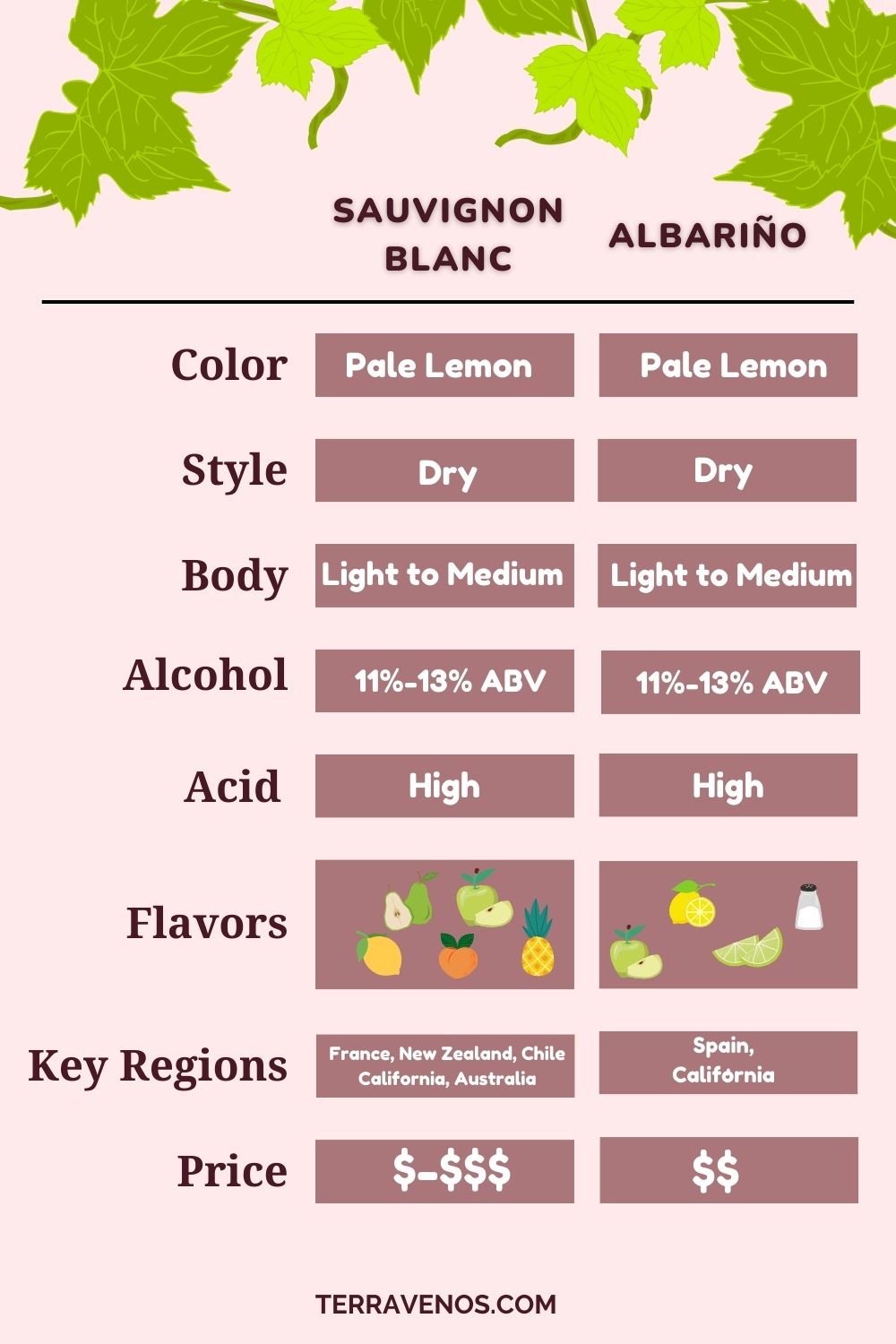
Albariño vs Sauvignon Blanc are logical wines to compare.
Both Albariño and Sauvignon Blanc are high acid, citrus-driven white wines. Sauvignon Blanc is more aromatic with green to tropical fruit. Entry-level Sauvignon Blanc is more widely available than Albariño, but you’ll find both wines delicious at $15-$20 USD.
TL;DR: If you love Sauvignon Blanc, you’ll enjoy Albariño.
Here’s what you need to know about the differences between Sauvignon Blanc and Albariño.
- Albariño Basics: A Coastal Queen
- Sauvignon Blanc: Also Zippy
- Contrasting Characteristics: Albariño vs. Sauvignon Blanc
- Sauvignon Blanc vs. Albariño: Food Pairings and Serving Temperature
- Which Is More Expensive, Sauvignon Blanc vs Albariño?
- Which Is Better? Sauvignon Blanc vs Albariño
- Final Thoughts – Albarino vs Sauvignon Blanc
Albariño Basics: A Coastal Queen
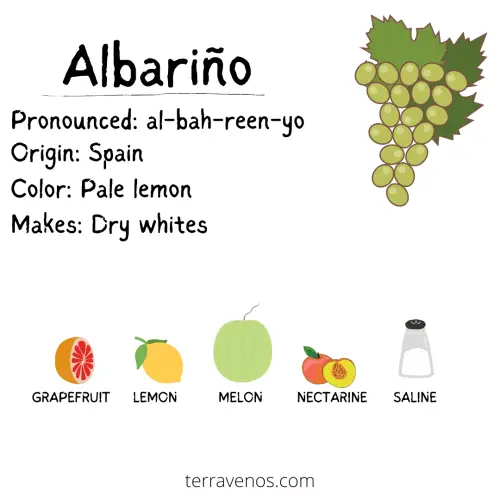
Albariño, a gem from Spain’s Rías Baixas region in Galicia, captures the essence of its maritime terroir. This zesty white wine boasts a vibrant acidity that enlivens the palate. Albariño embodies refreshing citrusy notes, accompanied by hints of floral elegance.
Its crisp and invigorating profile makes it a perfect companion for seafood dishes. Think oysters, fish and chips, ceviche, and more.
In Rías Baixas, where Albariño reigns supreme, the wine reflects the region’s coastal charm. The combination of cool ocean breezes and mineral-rich soils imparts a unique character to the grapes, resulting in wines that embody the spirit of the Galician coastline. Helpful Tip: Go check out this post for a deep dive into Albariño wine.
Fun Wine Fact: The name “Albariño” is derived from the word “Alba,” which means white in Galician, reflecting the grape’s light color.
Famed Albarino Winegrowing Regions:
- Rias Baixas, Spain
- Northern Portugal
- Coastal California
- Oregon
- New Zealand.
Sauvignon Blanc: Also Zippy
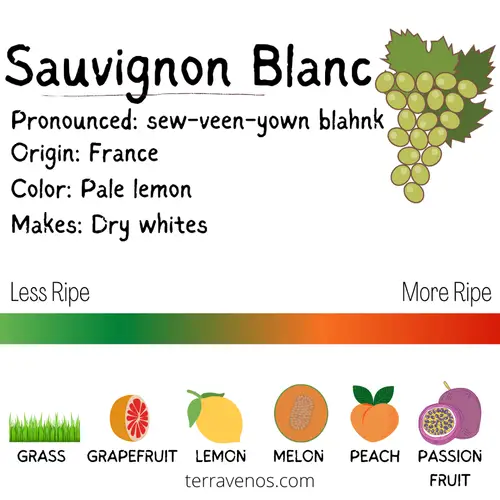
Originally from Loire, France, Sauvignon Blanc has earned worldwide fame for its zesty and lively nature.
Today, this grape thrives in various wine regions worldwide, including New Zealand, California, and Chile. Sauvignon Blanc showcases a light to medium-bodied profile, brimming with flavors of grapefruit, lime, passionfruit, and sometimes a subtle herbal twist. Winemakers often ferment Sauvignon Blanc in stainless steel tanks to preserve its bright acidity and fruit-forward character.
As one of the most beloved white wine varieties, Sauvignon Blanc caters to different budgets. From everyday sippers to premium selections crafted by renowned wineries, there’s a Sauvignon Blanc for everyone to enjoy. Check out this deep-dive on Sauvignon Blanc.
Fun Wine Fact: Sauvignon Blanc, Cabernet Sauvignon, and Cabernet Franc are all related and share that distinctive green grassy aroma.
Famed Sauvignon Blanc Winegrowing Regions:
- Marlborough, New Zealand
- Napa Valley AVA, California, USA
- Loire Valley, France
- Casablanca Valley, Chile
- Marlborough, New Zealand
- Stellenbosch, South Africa
Helpful Tip: Here’s a quick overview of 11 different wine regions and their signature wine styles. Go check it out!
Contrasting Characteristics: Albariño vs. Sauvignon Blanc
When it comes to Albariño and Sauvignon Blanc, these two white wines share several key characteristics.
| Characteristics | Albariño | Sauvignon Blanc |
|---|---|---|
| Hue | Pale lemon to gold | Pale lemon to greenish |
| Color | White | White |
| Aromas | Citrus, peach, saline | Herbaceous, grassy, citrusy, tropical, passionfruit |
| Sweetness | Dry | Dry |
| Acid | High | High |
| Alcohol (%) | 11.5-13.5% | 12-14% |
| Body | Light to medium | Light to medium |
| Intensity | Moderate to pronounced | Moderate to pronounced |
| Key Growing Regions | Rias Baixas (Spain), Portugal | France, New Zealand, California |
| Classic Pairings | Seafood, shellfish, salads | Seafood, salads, chicken |
| Price Range | $15-$30 | $10-$30 |
Albariño Wine Profile
- Sweetness: Albariño wines tend to be dry, offering little to no residual sugar.
- Alcohol: Typically, Albariño wines have a moderate alcohol content, ranging from around 11% to 13% ABV.
- Body: Albariño wines generally have a medium body, providing a satisfying weight on the palate.
- Acid: Albariño is renowned for its vibrant acidity, which adds freshness and liveliness to the wine.
- Aroma and Intensity: Albariño boasts pronounced flavors and aromas, with a focus on citrus notes, especially lemon and lime.
- Flavors: In addition to citrus, Albariño often exhibits flavors of green apple, peach, apricot, and sometimes a hint of saline minerality.
Sauvignon Blanc Wine Profile
- Sweetness: Sauvignon Blanc wines are almost always dry, but some entry-level bottles may have a little sugar making them off-dry
- Alcohol: Sauvignon Blanc has medium alcohol, in the 12%-14% range
- Body: Sauvignon Blanc presents a light to medium-bodied profile, offering a refreshing and zesty experience.
- Aroma and Intensity: Sauvignon Blanc almost always has an intense aroma profile with citrus, tree fruit, stone fruit, and even tropical notes. Sauvignon Blanc will have an herbal quality to it.
- Flavor: Vibrant flavors of citrus, tropical fruits, and sometimes a hint of herbal and mineral notes.
Is Albariño similar to Sauvignon Blanc?
Yes, Albarino and Sauvignon Blanc taste similar. They share vibrant acidity and forefront citrus flavors, like lemon and lime. They both pair with lighter dishes and have refreshing acidity to complement seafood. If you enjoy Sauvignon Blanc, you’ll like Albariño.
What Is the Difference Between Sauvignon Blanc and Albariño Wine?
Albariño can also have saline or mineral notes thanks to coastal vineyards. Sauvignon Blanc has a wide range of aromas and flavors from citrus to tropical depending on where the grapes are grown.
Sauvignon Blanc vs. Albariño Winemaking
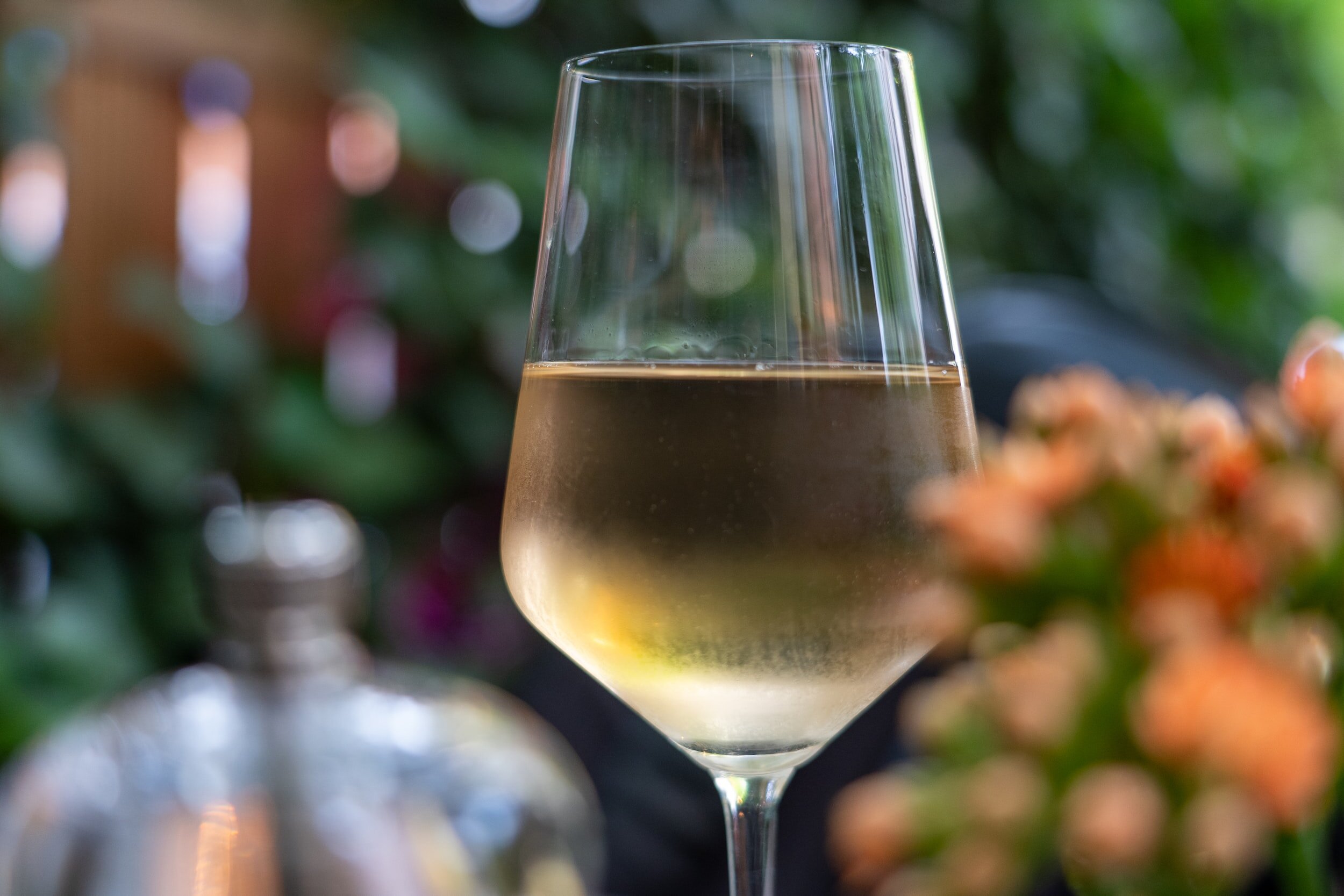
Both Sauvignon Blanc and Albariño go through protective winemaking to minimize oxidation and maximize freshness. This means using stainless steel and temperature-controlled fermentation.
Of course, winemakers love to experiment with winemaking styles, and you’ll find innovative Sauvignon Blancs and Albariños made around the world that are barrel fermented, fermented on the skins, and much more.
If you’re fortunate enough to find these wines, be sure to give them a try and sip with an open mind.
Sauvignon Blanc vs. Albariño: Food Pairings and Serving Temperature

When it comes to food pairings, Albariño and Sauvignon Blanc work well with the same types of cuisine. Their zesty acidity and citrus notes make them a perfect match for coastal seafood dishes, shellfish, and light salads. The wines’ acid compliments these dishes and naturally accentuates their flavors with a refreshing touch.
Helpful Tip: If you’re just getting started with wine, head over to the post that covers just the basics of food and wine pairing.
Both Albariño and Sauvignon Blanc are best enjoyed chilled. Stick them in the refrigerator overnight or at the very least a few hours before drinking.
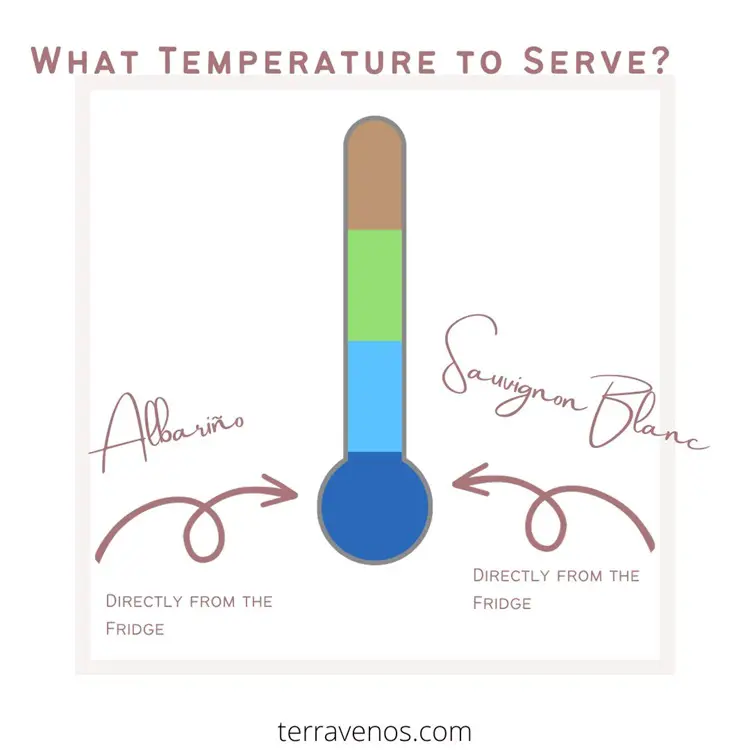
Helpful Tip: Ever get confused with recommended serving temperatures? Here’s a breakdown of wine serving temperatures and different wine styles and how you can use them in real life.
Which Is More Expensive, Sauvignon Blanc vs Albariño?

When comparing the prices of Sauvignon Blanc and Albariño, it’s natural to wonder which one is more expensive. Let’s break it down:
Wine Prices and Quality Levels
| Quality Level | Sauvignon Blanc | Albariño |
|---|---|---|
| Entry-level | $8 – $15 | $12 – $20 |
| Premium | $25 – $50+ | $25 – $50+ |
How Much Does Sauvignon Blanc Cost?
- Entry-level Sauvignon Blanc wines are quite affordable, typically ranging from $8 to $15 per bottle. These options provide a budget-friendly choice without compromising on the refreshing and crisp flavors that make Sauvignon Blanc so popular.
- If you’re looking to treat yourself to a premium experience, you can find higher-priced Sauvignon Blanc wines. These bottles, priced around $25 to $50 or even higher, offer a more complex and nuanced drinking experience.
Helpful Wine Buying Tip: Sauvignon Blanc is the more popular wine and so you’ll find less expensive bottles more readily available than Albarino. High-end Sauvignon Blanc, like Sancerre, is worth the money to taste at least once.
How Much Does Albariño Cost?
- Similar to Sauvignon Blanc, entry-level Albariño wines also come at accessible prices, usually falling within the $12 to $20 range per bottle. These wines are known for their vibrant acidity and refreshing characteristics, making them versatile for casual sipping or food pairing.
- On the premium side, Albariño reveals its elegance and expressive flavors. Premium Albariño wines, sourced from renowned regions, can be priced from $25 to $50 or even higher, delivering a memorable drinking experience.
Exploring different price points within each varietal allows you to find a Sauvignon Blanc or Albariño that aligns with your taste preferences and budget.
Helpful Tip: Sauvignon Blanc is definitely a wine you’ll find at your local grocery store. Check out this post for 9 quick tips on how to buy great grocery store wines.
Which Is Better? Sauvignon Blanc vs Albariño
If you want a high-acid white wine with tropical fruit, a warm climate Sauvignon Blanc is better. If you enjoy saline minerality, Albarino is better. If you’re concerned about price, you’ll find inexpensive Sauvignon Blanc more easily than Albarino.
Final Thoughts – Albarino vs Sauvignon Blanc
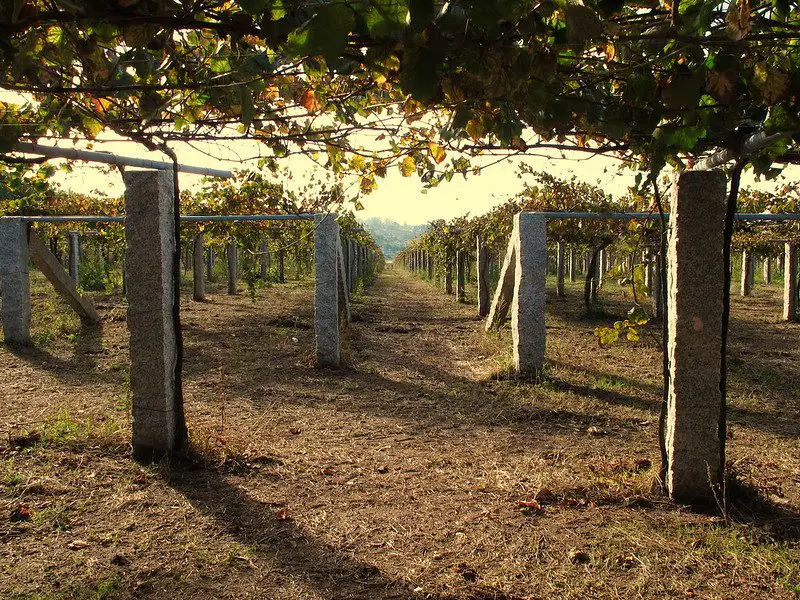
Albariño and Sauvignon Blanc are similar white wines that need to be enjoyed side-by-side. Sauvignon Blanc and Albariño both have the intensity of flavor that many wine drinkers look for.
Your Challenge: Get a similarly priced bottle of Albarino and Sauvignon Blanc and host a DIY tasting this weekend.
Thirsty for More?
Discover More:
Pinot Grigio vs Vermentino
Sauvignon Blanc vs Pinot Grigio
Pinot Grigio vs Pinot Blanc




